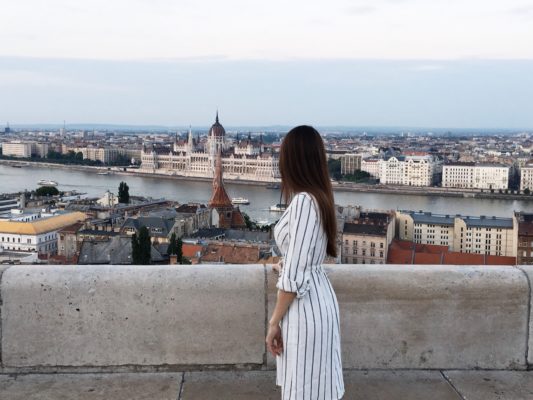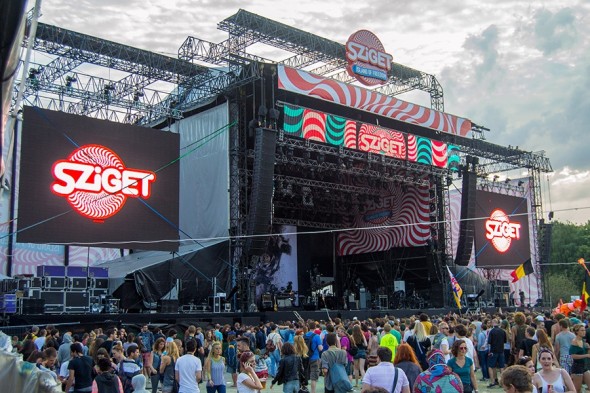Guest blogger: Sabrina Alexandre, Glazer Global Learning Scholarship Recipient, visited Hungary in May as a member of the Venture Advising Consulting Course. She will also be studying abroad next Spring in Scotland.
A Visit to the House of Terror
“Americans are united by a shared image of the future, but Hungarians are united by a shared image of the past.”
We were all sitting around the conference room table for our first day at the firm in Budapest when our professor stated those words. He was close to wrapping up a PowerPoint on Hungarian history when he started to share his past experiences living in the US. He shared a long list of differences between the two countries but he wanted us to understand how powerful a nation’s shared vision can be. For Hungarians, the past was something too fresh in their collective memory for them to escape.
 One place we visited brought that vision of the past to life: the House of Terror. Something with the name “House of Terror” almost seemed villainesque, like the lair of the evil doer from your favorite cartoon as a kid. Everything about the outside felt grand and dramatic and it built up a lot anticipation. You could spot the building from blocks away in all directions. It was this tall gray fixture at the end of street. The neutral color did nothing to camouflage the building among its neighbors because one look above and you can see giant steel plates plunging out of the building with the letters RORRET meticulously carved into them. When the light shines through the letters, the word gets flipped and along the side of the building in big, bold and glowing letters to spell out TERROR.
One place we visited brought that vision of the past to life: the House of Terror. Something with the name “House of Terror” almost seemed villainesque, like the lair of the evil doer from your favorite cartoon as a kid. Everything about the outside felt grand and dramatic and it built up a lot anticipation. You could spot the building from blocks away in all directions. It was this tall gray fixture at the end of street. The neutral color did nothing to camouflage the building among its neighbors because one look above and you can see giant steel plates plunging out of the building with the letters RORRET meticulously carved into them. When the light shines through the letters, the word gets flipped and along the side of the building in big, bold and glowing letters to spell out TERROR.
The House of Terror is the museum that holds the shared Hungarian vision. Inside that building is the story of the country under both Nazi and Soviet occupation. Until recently, the people of Hungary were under the strict control of the Soviet Union and before that, they were occupied by the Nazis during World War II. Generations of Hungarians were held captive in their own homes.
The House of Terror was split down the middle. Half of the museum was dedicated to the atrocities of World War II and the other half showcased the terrors of being under Russian rule. Imagine one room, but one side there’s a Nazi Uniform and videos from World War II and on the other side there were Soviet uniforms and videos from their occupation. The displays blended the two eras to form this continuous memory of oppression.
Some rooms had pictures and videos, some showcased testimonials from survivors like any other museum, but others displayed the original cars of the eras. We even toured the secret jail cells in the basement.
 As you’re walking through the galleries you are reminded of the many Hungarians, like our professor, who still have first hand accounts of these events because they are so recent. I couldn’t handle being in that building for more than an hour, but so many Hungarian citizens live with those memories everyday. You can see the city healing, but the scars are only now starting to fade away.
As you’re walking through the galleries you are reminded of the many Hungarians, like our professor, who still have first hand accounts of these events because they are so recent. I couldn’t handle being in that building for more than an hour, but so many Hungarian citizens live with those memories everyday. You can see the city healing, but the scars are only now starting to fade away.
The tour of the House of Terror had left me completely drained. The building was designed to present visitors with a nonstop feeling of dread, and I felt it. After being inside for an hour, I wanted to escape. As I watched old men on the screen recollect their lives under Nazi and Russian rule, it dawned on me that they had to survive both eras of oppression. The fact that this could happen, but remain relatively untold by our history books, is depressing. I had to travel halfway around the world to understand the fate that the people in Eastern Europe were dealt.
To be honest, I could have been presented with a documentary from the comfort of my home and it would not have had the lasting impact that each exhibit had. It’s one thing to read it or even watch it on television but it’s another to stand inside the actual prison cells and think, how can anyone ever do this to another human being? Physically being in that space was too much to process in the moment. It was eye opening.
The people I met in Budapest were so happy and inviting and I find myself appreciating their hospitality even more after my trip to the museum. I can’t imagine living with those memories of oppression, but choosing to rise above them and still be so warm and welcoming to strangers.
Top Photo by Sam Whitfield and Creative Commons License
Other photos provided by guest blogger




 Our work with the client, GPS Tuner, introduced us to the struggles of a fragmented market and how a setup like this can lead to beneficial results for an incumbent market leader. From an academic standpoint, it’s easy to fall into the trap of thinking that all markets operate as efficiently as possible, making it very difficult to sustain a competitive edge.
Our work with the client, GPS Tuner, introduced us to the struggles of a fragmented market and how a setup like this can lead to beneficial results for an incumbent market leader. From an academic standpoint, it’s easy to fall into the trap of thinking that all markets operate as efficiently as possible, making it very difficult to sustain a competitive edge. Although our time in Budapest has been short, it has provided a tremendous opportunity for both academic and personal growth. We’ve received excellent feedback from Professor Orban, which has guided our analysis and allowed us to set up a framework for our project going forward.
Although our time in Budapest has been short, it has provided a tremendous opportunity for both academic and personal growth. We’ve received excellent feedback from Professor Orban, which has guided our analysis and allowed us to set up a framework for our project going forward.
 Sziget attracts over 400,000 attendees a year, but essentially all are from Europe. In fact, only an estimated 200 Americans purchased tickets for last year’s festival. The task that we were given was to develop a plan for raising awareness of Sziget in the United States with a stated goal of increasing American attendance to 3,000 by 2018 (a 1500% increase). Sziget wants to diversify the origin of their attendees to protect against isolated economic difficulties and to drive 7-day ticket sales versus single day tickets.
Sziget attracts over 400,000 attendees a year, but essentially all are from Europe. In fact, only an estimated 200 Americans purchased tickets for last year’s festival. The task that we were given was to develop a plan for raising awareness of Sziget in the United States with a stated goal of increasing American attendance to 3,000 by 2018 (a 1500% increase). Sziget wants to diversify the origin of their attendees to protect against isolated economic difficulties and to drive 7-day ticket sales versus single day tickets.


